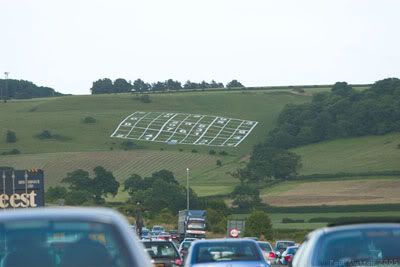My twitter Updates

Puzzle Craze, Sudoku
Wednesday, August 31, 2005
If you haven't heard of it yet, sudoku is the newest puzzle craze to sweep the United States and the UK. It's kind of like a crossword, but with numbers instead of letters.
Sudoku? What's sudoku a Sudoku you ask?
Sound more like a Japanese martial art, Sudoku is a logic puzzle. You fill numbers into a grid, using deduction (or, failing that, plain old trial and error). Each row and column must contain the digits 1 through 9, with each digit used only once. The best way to understand is probably to visit Sudoku.com, where there are clear explanations and some sample games. It's quite easy to learn.
The current fad in the UK stems mainly from the efforts of a single man: Wayne Gould, the guy behind the Sudoku.com Web site. A retired Hong Kong judge, Gould first spotted sudoku in Japan and was instantly hooked. He created a computer program that will compose new sudoku puzzles on demand. Then he walked into the Times of London offices without an appointment and convinced them to run his puzzles. Gould syndicates his sudoku grids for free, on the theory that he'll rake in money from books and the computer program. The Economist quotes him guessing he'll make $1 million in sudoku revenues this year.

A giant Sudoku board on the M4 in case you're stuck in traffic!
Recently in Australia, I noticed that instead of crossword puzzles, magazines and newspapers features Sudoku. Why does sudoku attracts?
IMHO, Sudoku's popularity is due to the difference between sudoku and crossword puzzle. Soduku is a puzzle of logic and not a puzzle of knowledge and literate playfulness. Thus, all you need is logic and recognizing number patterns and making a deduction instead of in-depth knowledge of words and it's different meanings.
For beginners, here are a few tips:
1) Use pencil, not pen, because there is a lot of erasing.
2) Work the 3-by-3 boxes first, because the clues are easiest to see. Once you've exhausted the boxes, then go to the rows and columns.
3) Once you've narrowed a square to two numbers, pencil them lightly into the boxes in the grid. You can come back and change them if you have to.
4) Don't guess. A good sudoku puzzle can be solved with pure step-by-step logic.
If you write the wrong number in a square, it can be difficult to figure out where you've made your mistake later. Unlike a crossword puzzle, where you can localize your mistake, with sudoku you can't always find where you went wrong and erase it.
More advanced techniques for solving sudoku:
5) If you've narrowed the possibilities down to two numbers for the square, row or column, then you know that no other square in that row, column or box have those digits.
6) When you get new information, always follow it through to its logical conclusion right then and there. If you fill in that information, try to fill in other information based on it while you're doing it.
Sudoku? What's sudoku a Sudoku you ask?
Sound more like a Japanese martial art, Sudoku is a logic puzzle. You fill numbers into a grid, using deduction (or, failing that, plain old trial and error). Each row and column must contain the digits 1 through 9, with each digit used only once. The best way to understand is probably to visit Sudoku.com, where there are clear explanations and some sample games. It's quite easy to learn.
The current fad in the UK stems mainly from the efforts of a single man: Wayne Gould, the guy behind the Sudoku.com Web site. A retired Hong Kong judge, Gould first spotted sudoku in Japan and was instantly hooked. He created a computer program that will compose new sudoku puzzles on demand. Then he walked into the Times of London offices without an appointment and convinced them to run his puzzles. Gould syndicates his sudoku grids for free, on the theory that he'll rake in money from books and the computer program. The Economist quotes him guessing he'll make $1 million in sudoku revenues this year.

A giant Sudoku board on the M4 in case you're stuck in traffic!
Recently in Australia, I noticed that instead of crossword puzzles, magazines and newspapers features Sudoku. Why does sudoku attracts?
IMHO, Sudoku's popularity is due to the difference between sudoku and crossword puzzle. Soduku is a puzzle of logic and not a puzzle of knowledge and literate playfulness. Thus, all you need is logic and recognizing number patterns and making a deduction instead of in-depth knowledge of words and it's different meanings.
For beginners, here are a few tips:
1) Use pencil, not pen, because there is a lot of erasing.
2) Work the 3-by-3 boxes first, because the clues are easiest to see. Once you've exhausted the boxes, then go to the rows and columns.
3) Once you've narrowed a square to two numbers, pencil them lightly into the boxes in the grid. You can come back and change them if you have to.
4) Don't guess. A good sudoku puzzle can be solved with pure step-by-step logic.
If you write the wrong number in a square, it can be difficult to figure out where you've made your mistake later. Unlike a crossword puzzle, where you can localize your mistake, with sudoku you can't always find where you went wrong and erase it.
More advanced techniques for solving sudoku:
5) If you've narrowed the possibilities down to two numbers for the square, row or column, then you know that no other square in that row, column or box have those digits.
6) When you get new information, always follow it through to its logical conclusion right then and there. If you fill in that information, try to fill in other information based on it while you're doing it.
